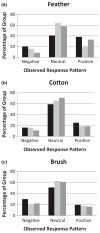Sensory processing in internationally adopted, post-institutionalized children
- PMID: 20738449
- PMCID: PMC3119572
- DOI: 10.1111/j.1469-7610.2010.02255.x
Sensory processing in internationally adopted, post-institutionalized children
Abstract
Background/methods: Sensory processing capacities of 8-12-year-old internationally adopted (IA) children who experienced prolonged institutional care (> 12 months with 75% of pre-adoption lives in institutional care) prior to adoption into family environments (PI) were compared to a group of IA children who were adopted early (< 8 months) predominantly from foster care with little or no institutional experience (EA/FC) and another group of non-adopted (NA) children raised by their birth parents in the United States. All children had estimated IQs within the normal range and did not evidence major neurodevelopmental disorders (e.g., cerebral palsy, fetal alcohol syndrome, Down's syndrome). Sensory processing was evaluated with a commonly used parent-report measure and a laboratory assessment.
Results: Children who had experienced prolonged institutionalization showed higher levels of reactivity to sensation and displayed both more aversion and approach to sensory stimuli than the other groups. The comparison groups (EA/FC & NA) did not differ on any of the sensory processing measures.
Conclusions: These results suggest that early institutional rearing which typically involves both sensory and social deprivation is associated with problems in sensory modulation capacities.
© 2010 The Authors. Journal compilation © 2010 Association for Child and Adolescent Mental Health.
Conflict of interest statement
Conflict of interest statement: No conflicts declared.
Figures
Similar articles
-
Behavioral and emotional symptoms of post-institutionalized children in middle childhood.J Child Psychol Psychiatry. 2011 Jan;52(1):56-63. doi: 10.1111/j.1469-7610.2010.02294.x. J Child Psychol Psychiatry. 2011. PMID: 20649913 Free PMC article.
-
Moderating the Risk for Attention Deficits in Children with Pre-Adoptive Adversity: The Protective Role of Shorter Duration of out of Home Placement and Children's Enhanced Error Monitoring.J Abnorm Child Psychol. 2020 Sep;48(9):1115-1128. doi: 10.1007/s10802-020-00671-2. J Abnorm Child Psychol. 2020. PMID: 32607754 Free PMC article.
-
A three year follow-up of attachment and indiscriminate friendliness in children adopted from Romanian orphanages.Child Dev. 1998 Aug;69(4):1092-106. Child Dev. 1998. PMID: 9768488
-
International adoption as a natural experiment.J Pediatr Nurs. 2006 Aug;21(4):276-88; quiz 289. doi: 10.1016/j.pedn.2006.02.001. J Pediatr Nurs. 2006. PMID: 16843212 Review.
-
Age at adoption from institutional care as a window into the lasting effects of early experiences.Clin Child Fam Psychol Rev. 2013 Jun;16(2):101-45. doi: 10.1007/s10567-013-0130-6. Clin Child Fam Psychol Rev. 2013. PMID: 23576122 Free PMC article. Review.
Cited by
-
The role of learning in social development: Illustrations from neglected children.Dev Sci. 2017 Mar;20(2):e12431. doi: 10.1111/desc.12431. Epub 2016 May 19. Dev Sci. 2017. PMID: 27197841 Free PMC article.
-
The Neurobiology of Attachment to Nurturing and Abusive Caregivers.Hastings Law J. 2012 Aug;63(6):1553-1570. Hastings Law J. 2012. PMID: 24049190 Free PMC article.
-
A translational neuroscience perspective on the importance of reducing placement instability among foster children.Child Welfare. 2013;92(5):9-36. Child Welfare. 2013. PMID: 24923133 Free PMC article. Review.
-
Gross motor development in children adopted from orphanage settings.Dev Med Child Neurol. 2012 Jun;54(6):527-31. doi: 10.1111/j.1469-8749.2012.04257.x. Epub 2012 Mar 13. Dev Med Child Neurol. 2012. PMID: 22413752 Free PMC article.
-
Sensory Processing Assessment and Feedback in the Treatment of Complex Developmental Trauma.J Child Adolesc Trauma. 2024 Feb 26;17(2):677-690. doi: 10.1007/s40653-023-00607-0. eCollection 2024 Jun. J Child Adolesc Trauma. 2024. PMID: 38938944 Free PMC article.
References
-
- Ahn RR, Miller LJ, Milberger S, McIntosh DN. Prevalence of parents’ perceptions of sensory processing disorders among kindergarten children. American Journal of Occupational Therapy. 2004;58:287–293. - PubMed
-
- Astley S. FAS Facial Photographic Analysis Software. FAS Diagnostic & Prevention Network. Seattle, WA: University of Washington; 2003.
-
- Ayres AJ. Tactile functions. Their relation to hyperactive and perceptual motor behavior. American Journal of Occupational Therapy. 1964;18:6–11. - PubMed
-
- Ayres AJ. Sensory integration and the child. Los Angeles: Western Psychological Services; 1979.
-
- Baranek GT, Boyd BA, Poe MD, David FJ, Watson LR. Hyperresponsive sensory patterns in young children with autism, developmental delay, and typical development. American Journal on Mental Retardation. 2007;112:233–245. - PubMed
Publication types
MeSH terms
Grants and funding
LinkOut - more resources
Full Text Sources
Medical
Research Materials
Miscellaneous


